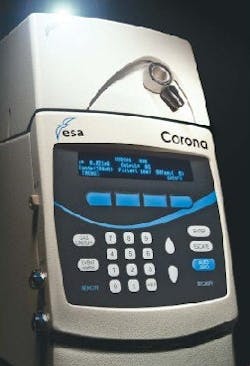What's the best way to detect and measure compounds with your HPLC? There is no simple answer. UV detection is the most widely used, but fails to see many compounds of interest. Other, so-called universal detectors have fallen short of the promise of combining application versatility with real performance.
Now there is an alternative the Corona Charged Aerosol Detector. Based on a unique, innovative detection method, the Corona detector offers numerous all-in-one performance advantages over refractive index (RI), low wavelength UV, evaporative light scattering (ELS) and chemiluminescence nitrogen (CLN) detectors:
- Excellent sensitivity
- Superior reproducibility
- More consistent response
- Wide dynamic range
- Broad applicability
- Intuitive operation
CAD (Charged Aerosol Detection) is a unique technology, in which the HPLC column eluent is first nebulized with nitrogen and the droplets are dried to remove mobile phase, producing analyte particles.
A secondary stream of nitrogen becomes positively charged as it passes a high-voltage, platinum corona wire. This charge transfers to the opposing stream of analyte particles.
The charge is then transferred to a collector, where it is measured by a highly sensitive electrometer, generating a signal in direct proportion to the quantity of analyte present.
Corona CAD shows consistent inter-analyte response independent of chemical structure. This means that the Corona detector can be used routinely for quantitation. The Corona CAD is a superior technology for achieving more accuracy in relative mass measurements.
Corona CADs method of detection allows quantitation across a range that exceeds four orders of magnitude. This large dynamic range allows the use of the Corona detector in applications where detecting compounds in widely varying amounts is important. The dynamic range of the Corona detector (low ng to high µg) closely matches the requirements for most HPLC methods, so CAD technology can be implemented with minimal impact on established procedures.
The Corona detector can effectively analyze a wide range of chemical structures and classes. For example, in a recent study of diverse compound classes, the Corona CAD detected all analytes (with the exception of Naphthol, a low-MW volatile compound), even compounds without chromophores.





